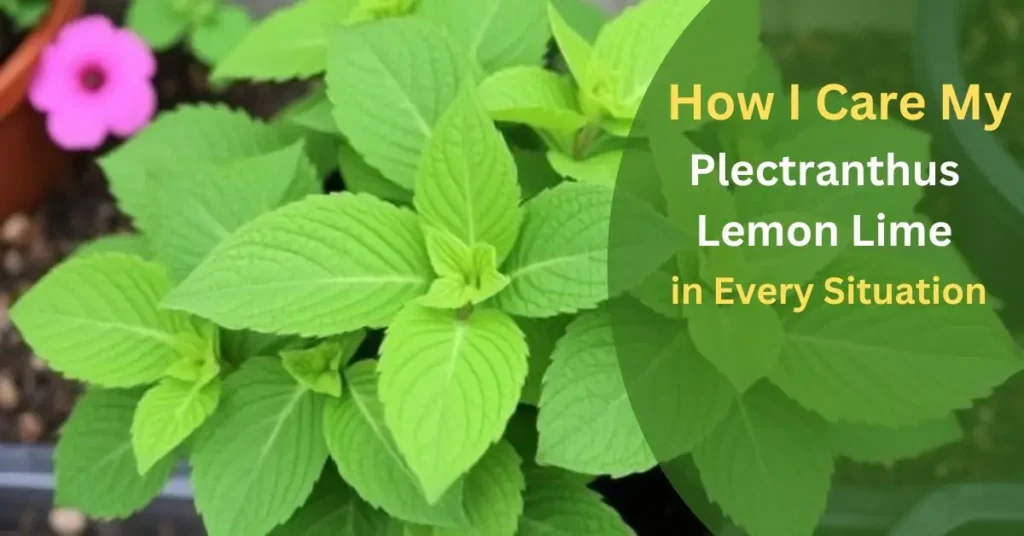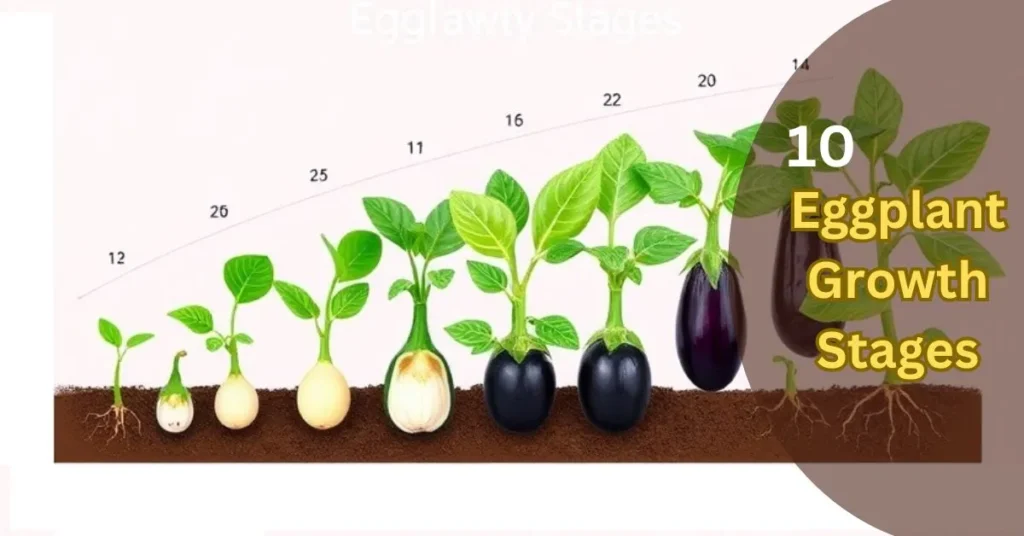Caring for my Plectranthus Lemon Lime has been a rewarding experience, both indoors and outdoors. Whether placed in pots, on the patio, or near a sunny window indoors, this lemon lime plant has thrived under the right conditions.
To ensure healthy growth, I follow a simple yet effective care guide that includes watering regularly but not excessively, and ensuring the plant receives ample indirect sunlight.
One of the tips I’ve learned over the years is that Plectranthus thrives best in well-drained soil, and providing a pot with proper drainage is key. It’s also important to monitor the plant health to prevent issues like root rot, especially if the plant is kept in pots.
When growing my Plectranthus Lemon Lime both indoors and outdoors, I pay close attention to the plant’s need for balance – not too much direct sun, but enough light to keep it thriving. Outdoor plants can handle a bit more exposure to sunlight, but indoor plants require a spot that doesn’t scorch them.
Over time, I’ve noticed that it’s not just about the right amount of sunlight; the plant care I provide, including occasional pruning and the use of a light fertilizer, contributes to the thriving plant I have today. Overall, it’s the little things, like ensuring good air circulation and plant tips like trimming dead leaves, that have kept my lemon lime flourishing year after year.
Key Points
| #- | Aspect | Details |
|---|---|---|
| 1- | Plant Type | Plectranthus Lemon Lime (Low-maintenance, Evergreen) |
| 2- | Best Growing Zones | Zones 9 to 11 (Tropical areas) |
| 3- | Preferred Climate | Tropical, suitable for natural climate |
| 4- | Planting Methods | Water Porgoation or Soil Porodgation (Choose based on your goals and location) |
| 5- | Indoor Care | For zones 1 to 6, keep the plant indoor to protect from extreme frost |
| 6- | Outdoor Care | In zone 8, plant outdoors but provide extra attention during cold spells |
| 7- | Soil & Watering | Requires appropriate soil and regular watering based on chosen planting method |
| 8- | Maintenance | Low-maintenance, requires little attention once settled |
| 9 | Recommended | Best for zones 9 to 11, thrives in tropical climates |
What’s the Intent of this Guide? – Only Care & Maintenance for My Plectranthus Lemon Lime Plant?
This guide provides care and maintenance tips for my Plectranthus Lemon Lime plant, covering its growing methods from the initial stage to full growth. I’ll explain how to care for it indoors and outdoors, sharing techniques to ensure healthy development.
Whether you’re using propagation methods or maintaining a thriving plant, this guide will help you with every step of the way.
By exploring its unique properties, I aim to give you the best caring guide, ensuring your plant has the right environment for healthy growth. With simple steps for plant maintenance, you’ll keep your Plectranthus Lemon Lime looking beautiful and strong in any setting.
What’s the Properties of My Plectranthus Lemon Lime Plant
The Plectranthus Lemon Lime is a beautiful and popular houseplant known for its vibrant lime green and yellow leaves, which bring a unique color and beauty to any garden or home.
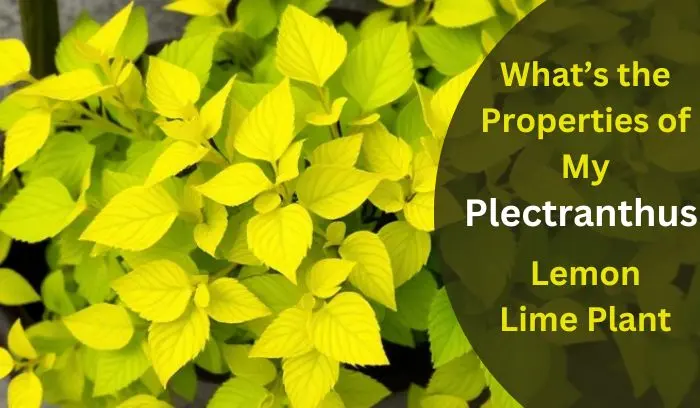
It is originally from South Africa and has become popular in many parts of the world due to its fast growth and low maintenance.
This tropical perennial flourishes in warmer regions and needs very little attention to thrive. It consistently produces fresh leaves each year, and its roots grow rapidly whether planted in water or soil.
Its simple care requirements make it an ideal choice for both novice and seasoned gardeners alike. As grandpa always said, the Plectranthus Lemon Lime is a low-maintenance plant that grows in a range of environments.
It belongs to the Lamiaceae family, also known as the mint family, and is an easy-to-care-for houseplant that adapts well to the ideal environment you provide. If you give it the right care, you’ll be rewarded with its strong, healthy growth and a thriving, special plant in your home.
Plectranthus lemon-lime-Popularity & Appearance
Herbaceous Perennial
The Plectranthus Lemon Lime is classified as a herbaceous perennial. This means it has a plant life cycle that lasts for several years. One of its distinct growth features is its soft stems, which are non-woody. Unlike many other plants, it doesn’t form hard, woody stems as it grows, making it unique in its plant characteristics.
Its vibrant lemon-lime colored leaves are part of what makes it an attractive choice for gardens or homes. This plant type thrives in soft growth and can be seen as a perennial plant, consistently producing new leaves year after year.
Its ability to maintain a lush appearance without requiring woody stems is what sets it apart from other plants in the same category. Lemon-lime plants are easy to grow and are a great addition to any garden due to their consistent beauty and long-lasting nature.
Swedish Ivy
Plectranthus, also known as Swedish ivy, is a perfect choice if you’re looking to bring life to your indoor spaces. This decorative plant is famous for its lush green leaves that can transform any room, making it look fresh and vibrant.
Whether you place it on a windowsill, hanging basket, or shelf, the plant adds an aesthetic touch with its trailing vines. In addition to its beautiful green appearance, Swedish ivy releases a light citrus fragrance, making the air feel fresher and more inviting.
A true gem for indoor gardening, Swedish ivy is relatively easy to grow and care for, making it an excellent choice for both beginners and seasoned plant lovers. Its ability to adapt to various indoor environments and its low-maintenance nature make it an ideal addition to your home. Not only will it provide a green touch to your home, but it will also enhance the overall look of your living spaces with minimal effort.
Ground Cover
The lemon lime plant is often referred to as a ground cover because it quickly spreads and covers the garden ground. Its lime-green leaves make it stand out and create a beautiful, lush carpet of greenery. As the plant grows, it sends out branches that help it spread across the soil, adding vibrant color and texture to your garden.
It’s a fantastic ground cover plant that not only enhances your garden’s appearance but also serves as a low-maintenance way to cover large areas of ground.
When planted, the lemon lime plant works wonders at covering the soil, and its leaves create a natural, fresh look that is perfect for both home gardens and larger spaces. It covers the ground quickly and efficiently, requiring little effort to keep it growing and thriving. This plant is ideal for creating a soft, green blanket in any garden or outdoor area.
Physical Features of Plectranthus Lemon Lime
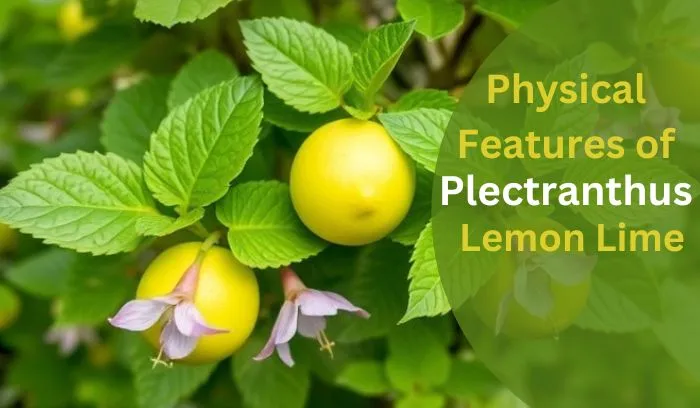
- Delicate, fibrous roots allow the plant to propagate quickly in water and soil.
- The plant has bright lime green leaves with rounded and jagged shapes.
- The leaves have a mix of soft and smooth textures.
- The stem has a woody base and an herbaceous stem that transitions to a trailing structure with a flexible nature.
- Typically, it grows 12-18 inches tall and spreads 2-3 feet wide.
- Occasionally, it produces lavender or pale blue flowers.
- The plant grows in a spreading, bushy form, making it perfect for use as ground cover or in containers.
- The aromatic, lemony fragrance helps freshen the air, adding a pleasant scent to the environment.
- Its compact shape makes it perfect for decoration.
Where Can I Use Plectranthus Lemon Lime?
The lemon lime plant is quite versatile and can be used for various purposes. Its leaves are especially easy to use, adding a unique combination flavor of mint and oregano to dishes. This makes it a perfect addition to any kitchen, bringing a refreshing taste to your meals.
Additionally, according to the NIH, several species from its genus Plectranthus have been approved for use in traditional medicine, making it a valuable plant not just for culinary purposes but also for health-related applications.
The lemon lime plant is also widely used for its aesthetic appeal. Whether in the garden or as an indoor plant, it adds a touch of beauty to any space. Its vibrant green leaves create a fresh and lively atmosphere in both garden and indoor spaces, making it a perfect choice for decoration while also serving practical uses.
How to Plant Plectranthus Lemon Lime: How to Care Also?
Ideal Climate for Plectranthus Lemon Lime Plant
Plectranthus Lemon Lime flourishes in warmer temperatures, ideally between 70°F and 75°F (21°C to 24°C). It grows best in zones 9 to 11, but in zone 8, it requires protection from extreme cold. For zones 1 to 7, it’s best to grow it indoors. The plant prefers loamy or sandy loam soil that is slightly acidic, moist, and moderately humid.
| Aspect | Details |
| Preferred Climate | Warmer climates |
| Temperature Range | 70F to 75F (21C to 24C) |
| Ideal Zones | Zones 9 to 11 |
| Protection Needed | Zone 8 (extreme cold) |
| Indoor Method | Zones 1 to 7 |
| Soil Type | Loamy, sandy loam |
| Soil pH | Slightly acidic |
| Soil Condition | Moist, moderately humid |
Best Temperature for Plectranthus Lemon Lime: From Initial Stage to Full Growth
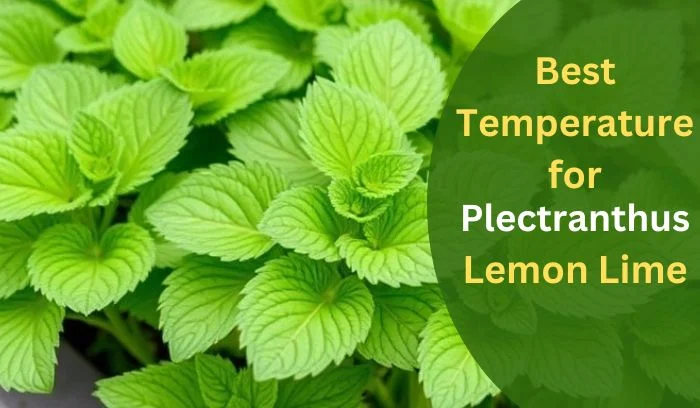
Starting Phase (Cutting or Propagation): 70°F to 75°F (21°C to 24°C)
When you start cuttings or propagation of the Plectranthus lemon-lime, the temperature plays a key role in ensuring healthy growth. During the initial stage, the plant must be placed in a warm environment where the roots can be established properly.
The ideal temperature for this stage is between 70F and 75F (21C to 24C), as this range supports proper root establishment and promotes early growth. Ensuring the roots are well-established underground is crucial for the plant’s successful development, setting the foundation for future growth.
This temperature range not only helps the plant in the initial stage but also aids in the overall propagation stage. Plectranthus lemon-lime needs consistent warmth for plant growth, making this temperature range perfect for the propagation process. Keeping the plant in this warm environment will result in a healthy foundation for later stages of growth.
Young Plant (Rooting Stage): 70F to 75F (21C to 24C)
When you are growing Plectranthus lemon-lime from a cutting, it is essential to keep the temperature between 70 to 75F (or 21 to 24C). This is the ideal range that encourages new growth and helps the roots develop well. The plant’s growth rate is positively impacted by the warmth at this stage, ensuring that the cutting establishes itself strongly.
A moderate heating rate is also needed for the roots to develop properly in this stage of growth. The temperature range of 70 to 75F supports healthy rooting and promotes the development of a robust root system.
With the right amount of warmth, the cutting will adjust to its new environment, and the roots will begin to establish themselves underground. This early growth is crucial for the overall health of the Plectranthus lemon-lime plant, ensuring it thrives in the coming stages.
Mature Plant (Full Growth) 70F to 80F (21C to 27C)
As the lime plant reaches its mature stage, it thrives in warmer temperatures between 70F to 80F (21C to 27C). Being a tropical plant, it requires warm and humid conditions to maintain its healthy growth and vibrant look.
The temperature range of 70F to 80F is essential for the full growth of the plant, helping it stay strong and lively. If you’re aiming for an optimal environment, these conditions are ideal for the plant’s health and development.
During the growth stage, the lime plant needs tropical conditions to ensure its success. It prefers a stable temperature and thrives in humid conditions, making the temperature of 70F to 80F critical for plant growth.
A consistent warm climate ensures the plant reaches its full potential, providing it with everything it needs for developing and maintaining a vibrant look. The proper temperature is not just beneficial, it’s required for its overall success.
Growing Methods for Plectranthus Lemon Lime
You can propagate Plectranthus lemon lime in two ways: Water Propagation and Soil Propagation. For Water Propagation, simply cut a healthy plant branch and place it in water until roots form. In Soil Propagation, cut the branch and plant it directly in soil. Both techniques help the plant develop and form roots.
Water Propagation: Take a healthy stem from the plant and submerge it in water.
To propagate a new lemon-lime plant using water propagation, start by cutting a healthy branch from an existing plant. Place the branch into a clean glass or container, ensuring that the lower part of the cut branch is fully immersed in water.
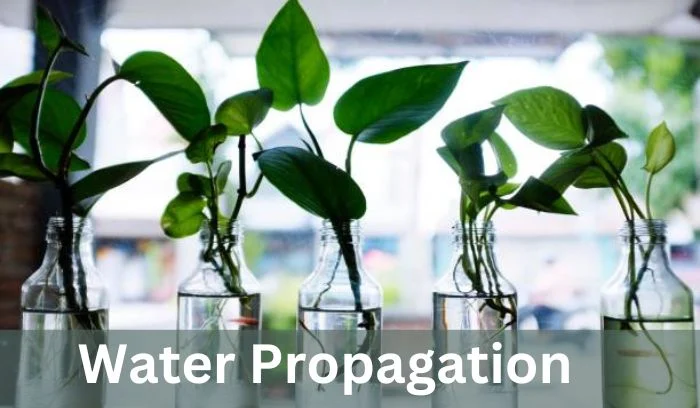
Be careful not to let the leaves touch the water, as this could cause them to rot. Place the container in a bright place, but avoid direct sunlight, which can be harmful to the cutting.
To keep the water fresh and prevent the growth of bacteria, change the water every three to four days. Over the next week or two, roots will start to emerge from the cutting. Once the root grows to about two inches in length, you can transfer the cutting into soil for further growth.
Soil Propagation: Cutting and Planting in Soil
When propagating Plectranthus Lemon-Lime through soil propagation, you start by taking a healthy branch from the plant. It’s essential to remove the leaves from the bottom of the branch so they don’t go into the soil. After that, place the branch in a well-drained and nutritious soil that is slightly moist, but not too wet, as this can cause the branch to rot.
Next, press the bottom of the branch into the soil to a depth of about one to two inches, making sure the soil is firm around it. Keep the plant in a bright place, but be careful to avoid direct sunlight, which can harm the cutting. Over the course of two to three weeks, roots will start to grow, turning the branch into a new plant. Once the roots are well-formed, you can choose to grow your plant outdoors or indoors, depending on your preference and available space.
Which method of growing is suitable for which side (indoor or outdoor?
For Plectranthus lemon-lime, the best growing methods depend on your location. Water propagation is best done indoors where you can maintain a stable water environment. Meanwhile, soil propagation is more suitable for outdoors as it allows the plant to root naturally in the soil. Each method works well in its ideal location, ensuring the best growth for your plant.
Indoor Planting Plectranthus Lemon Lime
To Brighten Your Space with Vibrant Leaves
If you’re looking to enhance your home decor, planting a Plectranthus Lemon Lime indoors is a perfect choice. The plant’s striking yellow and green leaves will instantly beautify any indoor space. Its vibrant foliage adds a splash of color and life, transforming your room with a fresh, natural look.
The vibrant hues of the leaves not only brighten your space but also give it an inviting, lively atmosphere. By placing this plant indoors, you can enjoy its color and the look of the leaves all year round. It’s an easy way to bring the outdoors inside while maintaining a sophisticated and cheerful environment.
The green and yellow tones are perfect for complementing other home decor, and the plant will thrive in bright spots away from direct sunlight, ensuring it continues to flourish and keep your space looking lively.
If you live in Cold Zones 1 to 7
If you live in cold climates, especially in zones 1 to 7, where the weather can drop as low as minus six degrees Celsius, indoor planting is a great option for your lemon-lime plants. The cold temperatures outside can harm the plant, making it difficult for it to thrive.
In these different regions, it’s important to bring your lemon-lime plant indoors to protect it from extreme temperatures. Even though the outdoor conditions may be harsh, growing your plant indoors in these zones is still appropriate and valid. This way, you can still enjoy a healthy, vibrant plant without worrying about the weather damaging it.
To Protect from Pests and Diseases
When it comes to indoor planting, it’s necessary to consider how to protect your plants from pests and diseases. Even though these issues are often more prevalent in outdoor environments, they can still affect your indoor plants, including Plectranthus Lemon Lime. It’s important to know that pests and diseases may be a concern in an indoor environment, so regular care and attention are key.
Taking proactive steps such as maintaining a clean area and monitoring your plants closely can help prevent the spread of harmful elements. Ensuring that your plants stay healthy and free from unwanted threats not only promotes growth but also keeps your indoor environment thriving.
So, if you want to keep your plants safe and protected, be sure to act before any issues arise, especially considering that they could be more common than you expect. Keep an eye out for any early signs of distress, and you’ll enjoy healthy greenery year-round.
In the Case of Small Spaces
If you have a tiny outdoor space, indoor planting can be the perfect solution to bring nature inside. Indoor planting is not only affordable, but it also allows you to adjust the temperature and humidity to suit your plants. This is particularly helpful for a plant like Plectranthus Lemon Lime, which thrives under controlled conditions.
You don’t need a large garden to enjoy the benefits of plants — even a small space can become a vibrant indoor oasis. Having the flexibility to control these factors accordingly makes it easier to keep your plants healthy and thriving.
Whether it’s a small apartment or a cozy room, the idea of indoor planting makes it possible to enjoy greenery no matter the size of your living area. By adjusting these elements, you can create the perfect environment for your plants, ensuring they flourish all year round.
Advantages of Growing Indoor Plants
There are many good reasons to choose indoor planting, especially when it comes to the Plectranthus Lemon Lime. This plant is easy to care for and is perfect for adding freshness and color to your home.
The beautiful leaves and light fragrance not only make it an excellent decoration but also improve the atmosphere. You don’t need direct sunlight to grow it, making it an ideal choice for any indoor space. With its ability to purify the air, it helps create a cleaner, healthier environment.
Adding plants like Plectranthus Lemon Lime to your home is an easy way to improve both the aesthetic and the air quality. Whether you’re looking for something to fill a small corner or bring some greenery to your living room, this plant is the best choice. It’s a simple yet effective way to bring nature indoors and enjoy the many benefits of having plants in your space.
How to Plant Plectranthus Lemon Lime Indoors
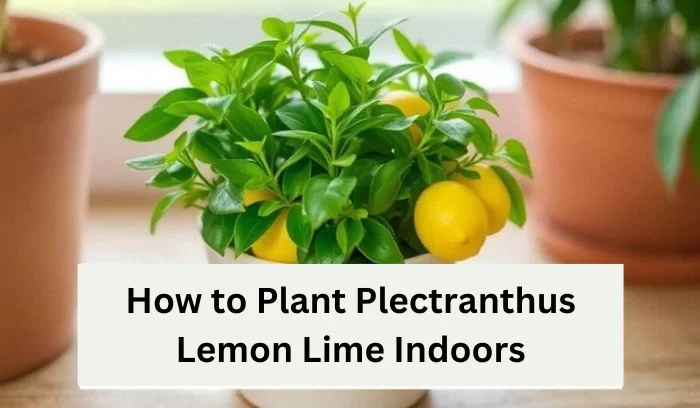
Which Growing Method is Ideal for Indoor Planting
When it comes to indoor environments, one of the most effective techniques is Water Propagation. This method is highly beneficial because it allows greater control over factors like temperature and light, ensuring optimal conditions for plants.
By using cuttings that are carefully placed in water, you can provide immediate moisture to the plant, which is vital for its survival and growth. This setup not only encourages root growth, but it’s also particularly useful when outside conditions are unstable. The absence of direct sunlight in indoor settings makes growing even more comfortable for this method.
As the cutting reaches 1 to 2 inches of roots, it’s time to transfer it into soil for further development. From there, you can move the seedling to creative spots like hanging baskets. This method allows you to experiment with various plants while maintaining an adaptable approach. Whether you’re just starting out or have experience, this strategy provides a seamless way to manage your indoor planting effectively.
How to Care for Plectranthus Lemon Lime Indoors
Watering Needs
Plectranthus Lemon Lime is a beautiful indoor plant that requires moderate watering. To keep it healthy, make sure to water the soil only when the top 1-2 inches of the soil feel dry. It’s important to avoid overwatering, as this can cause rooting within the roots, which can lead to damage.
The key is to provide just enough water, ensuring the soil is well-drained so that it doesn’t retain excess moisture. In colder months, it’s advisable to reduce the amount of water you give the plant, especially in winter, as the plant will need less moisture during this time. This routine helps maintain the plant’s health and ensures it thrives indoors.
Temperature and Humidity Control
To help your Plectranthus Lemon Lime thrive indoors, it’s important to create the ideal climate for its growth. During the initial stage, the temperature should be stable to support healthy development, but as it moves to total growth, you can adjust accordingly.
Ensure that the indoor space has a balanced humidity level for the plant. If your space is arid, spray water droplets around the plant to maintain the right humidity and prevent it from drying out. Monitor the humidity closely to ensure the plant is comfortable in its environment. This careful attention will encourage strong, consistent growth, and a healthy plant overall.
Light Requirements
For a healthy Plectranthus lemon-lime plant, it’s essential to provide the right lighting. This plant thrives on indirect light, so it’s best to keep it away from direct sunlight, which can burn the leaves.
While it likes full sunlight, exposure to direct rays can cause harm. If your room lacks natural light, you can use artificial grow lights to meet the plant’s needs. Placing the plant near a window can make it easier to get the proper light without being exposed to harsh sunlight.
Fertilization Tips
When caring for your Plectranthus Lemon Lime, it’s essential to use a balanced, water-soluble fertilizer for its good health. A common choice is the 10-10-10 or 20-20-20 NPK, which provides all the necessary nutrients.
You should fertilize the plant every four to six weeks during spring and summer. In the winter, stop fertilizing as the plant’s growth slows down. Always dilute the fertilizer to prevent over-fertilization. For a more organic approach, compost or liquid seaweed are great choices that offer natural nutrients without chemicals.
Pruning and Maintenance
To keep your lemon-lime plant looking healthy and presentable, regular pruning is essential. This helps control excess growth and ensures the plant stays bushy. Over time, it’s important to remove any dead leaves and damaged stems to prevent unnecessary strain on the plant.
Pinching the tips of the leaves during the growing season can also encourage new growth and keep the plant thriving. With this simple maintenance, your plant will continue to flourish indoors with ease.
Common Issues in Indoor Care and How to Solve Them
Yellowing Leaves
When the Plectranthus lemon-lime plant’s leaves turn yellow, it often points to an issue with watering or nutrition. If you’re giving it too much water, the plant can suffer, so it’s important to reduce the amount.
On the other hand, if the yellowing is caused by a lack of nutrients, you should address this by adding a balanced fertilizer to correct the nutritional deficiency. Always ensure you’re giving just the right amount of water, neither too much nor too little, to keep your plant healthy and vibrant.
Root Rot and Overwatering
Overwatering is a common issue that causes root rot in plants. When the soil becomes too soggy, it prevents the roots from breathing, leading to the growth of fungal infections. To avoid this, always use a well-drained pot with drainage holes to ensure excess water can escape.
If you notice rot in the roots, you will need to cut off the rotten roots and leave only the healthy ones. Moving forward, water only when the top couple of inches of the soil are completely dry. This helps in preventing overwatering and keeps your plant in good health.
Pest Control (e.g., Aphids, Spider Mites)
When aphids or spider mites appear on your Plectranthus lemon-lime, it’s essential to take action. If pests are present, you can spray the plant with neem oil or mild soapy water to avoid further damage.
Make sure to clean the leaves thoroughly, and if necessary, cut any damaged parts to keep the plant looking healthy. Regular maintenance helps to reduce pest-related problems, so keeping your plant clean is crucial for its long-term wellbeing.
Leggy Growth
If your lemon lime plant starts to look stretched out, with long and wide leaves, it may be a sign of low light. This is a common issue that causes leggy growth, where the plant grows tall and spindly instead of staying compact. To solve this, move your plant to a spot with good light. A little prune can also help it grow more compact and healthy. It’s a simple fix, but it keeps the plant looking full and vibrant.
Outdoor Planting of Plectranthus Lemon Lime
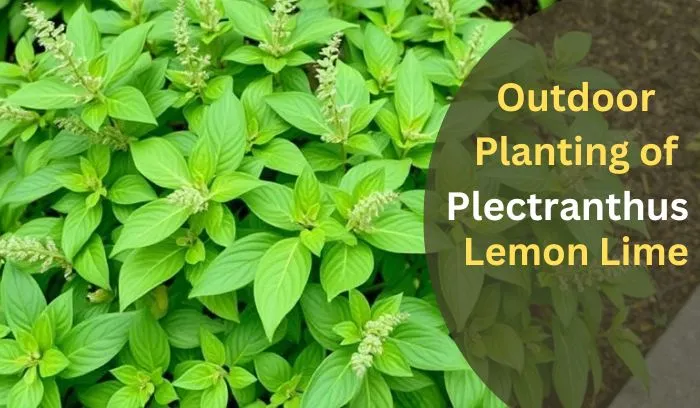
If you live in zones 9 to 11
If you reside in zones 9, 10, or 11, you’re fortunate! These zones have warmer climates, which are the perfect natural conditions for planting your lemon lime plant outdoors. This is the foremost reason why people choose to grow Plectranthus lemon lime in these regions. The warm temperatures allow the plant to thrive, making it ideal for those living in these zones.
Growing lemon lime outside in zones 9 to 11 offers the best opportunity for a healthy, thriving plant. The warmer climates ensure that your plant receives all the sunlight and warmth it needs to flourish, with minimal effort required on your part.
To enhance Outdoor space with its compact feature
If you want to enhance your backyard or yard, consider incorporating plants with yellow-greenery leaves. These plants can bring a beautiful touch to your outdoor space, creating a lush and inviting atmosphere. Their compact feature makes them ideal for smaller areas, as they don’t require much space but still deliver a vibrant, natural look.
Using plants with such features can transform even a small backyard into a serene retreat. Whether you are working with a tiny yard or simply want to add more green to your outdoor area, these plants are a great choice. The compact nature of the plants ensures they don’t overcrowd the space, allowing you to enjoy a well-maintained and aesthetically pleasing environment.
To provide natural climate conditions
If you live in zones 9 to 11, you’ll be in the perfect area to grow plectranthus lemon-lime. This plant prefers warmer climates and thrives best in these natural conditions. These zones offer the ideal environment for the plant, where it can flourish in the surroundings it loves. It’s important to note that lemon-lime varieties will struggle in cooler climates, so planting in warmer zones will ensure it gets the right climate it needs to grow strong and healthy.
Benefits of Planting Plectranthus Outdoor
Planting Plectranthus lemon-lime outdoors has many benefits. These plants thrive in the natural sunlight, which is essential for their growth. They also enjoy the fresh air, keeping them healthy and protecting them from diseases.
Outdoor planting gives them ample space to grow in their natural size and shape, which makes them even more attractive. With the help of rainwater, these plants get hydration, making watering easier for you and reducing maintenance.
Additionally, planting Plectranthus in your garden creates a beautiful environment that attracts wildlife like birds and pollinators. This not only benefits your garden but also promotes a healthy ecosystem. The overall aesthetic value of your outdoor space is enhanced, and the presence of these plants encourages biodiversity.
How to Plant Plectranthus Lemon Lime Outdoors
Which Growing Method is Ideal for Outdoor Planting
When it comes to growing your lemon lime plant outdoors, soil propagation is an excellent method. In this process, cuttings are placed in a seedbed and allowed to grow naturally in the soil.
This technique provides the plant with the necessary nutrients for healthy growth. The roots develop well in the soil, helping the plant become stronger and more resilient to changes in the weather and outdoor environment.
The beneficial nature of this method lies in its simplicity and effectiveness. It is a straightforward process that requires minimal care but offers maximum benefits. The plant becomes accustomed to the outdoor conditions, ensuring it remains healthy while benefiting from the natural elements around it. With this approach, your lemon lime plant will thrive in its new outdoor space.
How to Care Plectranthus Lemon-Lime Plant Outdoors
Watering and Drainage
Watering is essential for your lemon-lime plant when grown outdoors, but it’s important not to overwater or underwater. The goal is to keep the soil moist, but not allow it to stagnate, which can harm the plant. Good drainage is crucial for the roots to receive the oxygen they need.
To improve drainage, you can add compost or sand to the soil. These materials help water flow freely and prevent the roots from becoming waterlogged, ensuring your lemon-lime plant thrives.
Sunlight and Shade Requirement
When planting lemongrass outdoors, it is important to avoid placing it in direct sunlight for long periods, as it can cause the leaves to burn. Instead, the plant thrives best in partial shade, so consider placing it outside where it gets some protection, such as under a tree or near a building. This provides the light shade the plant needs to stay healthy and maintain its green color.
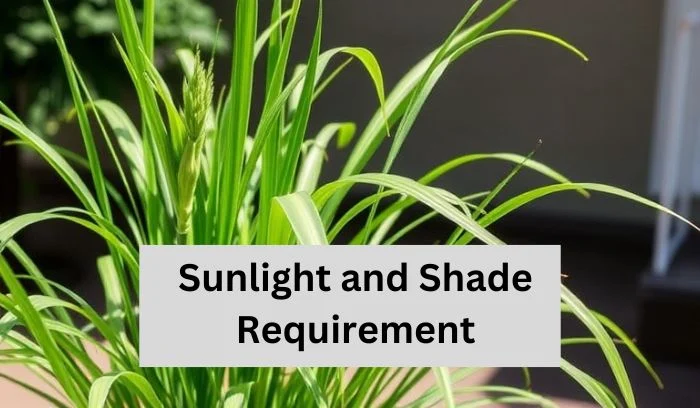
Finding the right balance of light for your lemongrass is essential to ensure it grows strong and vibrant without suffering from excessive exposure to the sun. The plant requires enough light to grow, but too much direct sunlight can damage it, leading to unhealthy growth.
Temperature Considerations
When caring for plants, it’s crucial to keep in mind their ideal temperature to ensure they thrive. Whether you keep your plants indoors or outdoors, they can be sensitive to drastic changes in temperature.
During winter, for example, plants are especially vulnerable to frost. If left outside in freezing conditions, the cold can cause significant damage, leaving your plants weakened or even destroyed. To prevent this, it’s often better to bring them indoors when temperatures drop.
On the other hand, extreme heat can also harm plants, causing them to wilt and dry out. Protecting them from direct sunlight or scorching temperatures is just as important as shielding them from cold. By maintaining the right balance and adjusting their environment accordingly, you can ensure that your plants stay healthy and strong throughout the year, regardless of the seasonal changes.
Fertilizing Outdoor Plants
When it comes to fertilizing outdoor plants, using the right kind of fertilizer at the right time is essential for healthy growth. You can apply a balanced liquid fertilizer every four to six weeks during the spring and summer to help your plants thrive.
Fertilizers like organic fertilizer are a great choice as they not only provide nutrients but also nourish the soil, encouraging natural growth. It’s important to apply the fertilizer occasionally, avoiding overuse to prevent over-fertilizing, which can harm the plants.
From my experience, even a small amount can make a big difference. When you apply the right amount, it can really promote strong roots and vibrant leaves, making your plants grow beautifully throughout the seasons. The key is to find a balance that works for your garden. By applying fertilizer correctly and sparingly, you allow your plants to thrive without overwhelming them with excess nutrients.
Pruning and Maintenance Outdoors
To keep your lemon lime plant healthy, it’s important to clean and prune it regularly. Every few weeks, you should be cutting off any dead leaves or parts that might be taking away energy from the plant. This simple care routine will help the plant grow better and even produce more new leaves.
Pruning not only helps improve the plant’s appearance but also encourages fresh growth, making it look vibrant and lively. If your lemon lime is getting too big, it’s also a good idea to prune it to control its size.
By trimming back the branches, you prevent the plant from becoming overgrown and maintain its shape. This can make a big difference in its overall health and appearance, helping it thrive even in tight spaces.
Common Outdoor Issues and Solutions
Pest Management Outdoors
To keep your lemon lime plant free from pests, it’s essential to inspect it regularly for any signs of insects or bugs. If you spot any pests, you can use a mild insecticide or neem oil to safely treat the plant. These natural solutions are effective without harming the plant’s health. Alternatively, you can clean the plants with water to gently remove the insects. This simple method helps keep your plants safe and clean.
In my experience, staying proactive is key. By taking a few minutes to inspect and treat your plants regularly, you ensure they stay healthy and pest-free. This routine is an easy but effective method to keep pests away from your lemon lime and other outdoor plants.
Dealing with Weather Extremes
When dealing with extreme weather conditions, it’s important to give your plants the proper care. If there is too much sun, placing the plant in a shaded area for a little time can help protect it from burning.
On the other hand, if there is too much rain, make sure the soil is well-drained so that water doesn’t accumulate around the roots, which could damage the plant. Proper drainage is key in maintaining healthy growth, especially during heavy rains.
In cold conditions, especially when the temperature drops, it’s best to cover the plant or bring it indoors to protect it from the cold. This simple action helps prevent frost damage and keeps the plant safe from extreme weather. By adjusting your plant care based on the weather, you can ensure it remains healthy and resilient no matter what nature throws its way.
Handling Soil and Drainage Issues
When planting outdoors, it’s important to consider the soil quality. If the soil is dense or contains a lot of clay, it can prevent water from properly draining, which can be damaging to the plant’s roots. To solve this, it’s essential to keep the soil light and well-drained.
One way to do this is by adding rotted manure or compost to the soil. These additions enhance drainage, ensuring the plant receives the water it requires without excess pooling around the roots.
If you’re planting in a pot, make sure the bottom has holes so the water can drain properly. By doing this, water won’t collect at the bottom and cause root rot. By ensuring good drainage in both garden soil and pots, you’ll help your plants thrive and avoid common soil-related issues.
How I care For Py Plectranthus Lemon-lime In Water
To care for my plectranthus lemon lime in water, I use a clear glass container. This type of vessel is perfect because it lets me see the developing roots and ensures they get enough light. I make sure the plant has plenty of room to grow and that the roots are submerged while the leaves stay above the water. I also pluck any leaves that are close to the water to avoid them touching the surface.
When it comes to maintaining the plant, I snip a cutting just below a node using sterilized scissors. This ensures that the cutting can grow new roots without any risk of infection. By following these steps, my plectranthus lemon lime thrives in water and stays healthy.
FAQs
Plectranthus leaves may turn brown due to too much water, exposure to direct sun, or a lack of nutrients. Pests and fungal infections can also cause leaf spots and rot, leading to browning leaves. Regular care and monitoring will help prevent this damage.
Plectranthus is a tender perennial that grows well in USDA zones 10-11. In cooler climates, it’s often grown indoors or as an annual. It’s popular for use in hanging baskets and as ground cover in frost-free areas. This hardy plant is a great choice for indoor decoration.
If your Plectranthus isn’t flowering, it may not be getting enough bright, indirect sunlight. Day-night temperature shifts are also crucial to trigger blooms. Ensure it’s planted in well-draining soil and use high phosphorus fertilizer to enhance flowering. After blooming, prune and deadhead to encourage repeat blooming.
Plectranthus is generally safe for humans. Major poison control centers and health organizations don’t list it as toxic, which is reassuring for plant enthusiasts. However, it’s still essential to take general safety considerations when handling plants to ensure safety.
Final Thoughts-How I Care My Plectranthus Lemon Lime Plant
Caring for my Plectranthus Lemon Lime has been easy, as it’s a low-maintenance and evergreen plant. It thrives in tropical areas like zones 9 to 11, where the climate is naturally suitable. When growing it, I recommend adopting either the water Porgoation or soil Porodgation method based on your location and goals. For zones 1 to 6, it’s best to keep it indoor to avoid extreme frost, while in zone 8, outdoor planting works well with a little attention.
The plant flourishes when planted in the right natural climate and receives proper care, including the right soil and water. Recommended for zones 9 to 11, it’s a perfect fit for tropical regions and is sure to thrive with minimal effort.
See Also:
How to Grow Plants Along a Vinyl Fence: Step-by-Step Guide
When to Seed Lemongrass in Zone 9a? A Complete Guide

